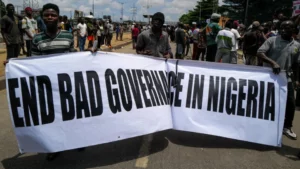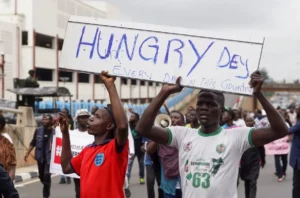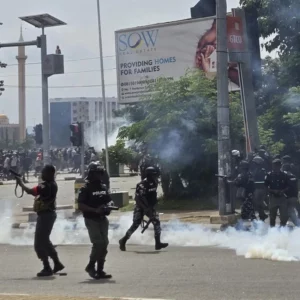Cost of living crisis sparks nationwide protest in Nigeria

Propositions for #DaysOfRage to protest hunger in the land, and #EndBadGovernance, started circulating on several social media platforms, in the wake of the revolt of the Kenyan youth.
Since 1 August, tens of thousands of people have trooped out onto the streets across Nigeria in nationwide #EndBadGovernance protests against hardship and hunger. This phase of the protest movement is expected to last until 10 August. Demonstrations have been held in the Federal Capital Territory, Abuja, and in 29 of the 26 states of the federation. In all eight states where there were no protests on the streets, residents joined the nationwide protest by sitting at home, as was the case in Enugu.
According to the organised private sector, the Nigerian economy lost N500bn ($305m) to the massquake on the first day alone.
At least 13 people were killed that day by security forces, who confronted protesters in some states with live bullets, according to Amnesty International. And by 3 August, the death toll, according to the Nigeria Labour Congress, might have risen to over 40. More than 1,200 people have been arrested. But all of this has failed to douse the mass anger driving the protests.
There were calls for the president to speak to the people, although the organisers stressed that they were more concerned with their demands being met than a mere presidential speech. Eventually, President Bola Ahmed Tinubu addressed the nation on Sunday. Not surprisingly, his speech was high on self-praise but low on any serious content about how people’s hardship would be ameliorated, beyond empty promises that these hard times would lead to greater prosperity in an undefined future.
In the course of his speech, he alluded to the protests being the design of “a few with a clear political agenda to tear this nation apart”, with a barely veiled threat to “ensure public order”. At the same time, he urged those protesters “who desired a better and more progressive country” to call off the protests and embrace dialogue.
Some reformists in the ranks of protesters, as well as some who are clearly fifth columnists, have echoed the call to end the protests in the wake of the president’s speech. Indeed, some, including a few ex-leftists, had asked the protesters to leave the streets after the first two days, saying their point had been made and, with violence in a number of states, there was no need to continue at the barricades.
But such positions do not represent the mood in the trenches of this movement. In Lagos, Abuja and across the country, the spirit of resistance has remained unbowed, despite increased attacks by the police and thugs aligned with the ruling party.
The road to #DaysOfRage

“We rather die of bullets than to die of hunger; we cannot stay at home and die of hunger.”
The main driver of this national protest is excruciating hardship and pangs of hunger driving millions of Nigerians to the edge of sanity and life itself, as a result of the economic policies of the current government. It has been the most thorough-going in implementing neoliberal policies. In fact, whilst speaking to business czars in Germany last November, President Tinubu declared that he deserved Guinness World Records recognition for economic reforms.
During his inauguration on 29 May 2023, he simply announced that the “petrol subsidy is gone”. This resulted in an immediate 240% increase in the fuel pump price. The currency also lost 70% of its value against the dollar, having been devalued in June 2023 and again at the beginning of 2024. An electricity tariff hike of upwards of 300% has devastated homes, businesses, schools and hospitals.
Consumer price inflation, which averaged 13% between 2002 and 2022, now stands at 34%. What this means in concrete terms to working people in the country is that millions of people can barely feed themselves, pay their rent, or afford healthcare in a country where over 76% of health expenditures are out-of-pocket. People now die from easily treatable ailments.
Meanwhile, the working class demand for a living wage, as the new national minimum wage, was treated with contempt. After much ado about nothing, organised labour settled for an increase in the national minimum wage from N30,000 to N70,000, which was signed into law in July. But real wages have actually declined and sharply so, once again. When N30,000 was agreed upon in 2019, its value was $83.50 (the value of the 2011 minimum wage of N18,000 was $115.68). But the new minimum wage of N70,000 is worth just $46.35.Working people in the informal economy are in an even more terrible state. There is hardly anywhere to turn to for credit. And other working people can hardly find money to pay for things purchased from them.
The generalised state of hardship and hunger of working people in the country was a recipe for rebellion.
The first wave burst out spontaneously at the beginning of February in the North Central state of Niger and Kano in the North West. Within two weeks it had spread to several states, including in other geopolitical zones, in both the Northern and Southern parts of the country. The entry of the Nigeria Labour Congress, when it declared 27-28 February as nationwide workers’ protest days, further generalised the momentum, even though the unions mellowed after only the first day. The wave continued into March in an atmosphere of an impending general strike, which the trade unions had created but failed to live up to. This contributed significantly to the petering out of that first act of an unfolding moment, of which the August #DaysOfRage is the second Act. But even at that time, it was clear to any discerning eye that the first round of protests heralded what could be a period of intense mass resistance to the state and its policies.
Propositions for #DaysOfRage to protest hunger in the land and #EndBadGovernance started circulating on several social media platforms in the wake of the revolt of the Kenyan youth. It was initially inchoate. The Take It Back movement, which was part of this discursive emergence online, stepped in, with Omoyele Sowore, its National Convener, conducting an online poll to distil out a shared set of demands. As calls for the action became sharpened, and the set date of 1-10 August drew closer, liberal reformists like the Labour Party’s Peter Obi, as well as the Nigeria Labour Congress and Trade Union Congress, made it clear that they were not going to be part of the protests, but urged the government to respect the protesters’ freedom of association and expression. Meanwhile, groups on the Left, with little if any traction in the emergent movement laid claim to being its ‘leaders’.
For its part, the Nigerian state brought out its whole bag of tricks to prevent the mass action from taking place. Several state officials issued threats that the government would smash any attempt to organise the #DaysOfRage protests. Blackmail and scaremongering were also thrown in for good measure. Pastors, bishops, imams, traditional rulers, academics and a host of such ‘well-respected’ people were brought in to echo the ruling class positions: the protests would lead to chaos, protests have never achieved anything, fifth columnists would hijack the protests even if they started as peaceful demonstrations, etc. The nefarious ethnic card was also shamelessly played, particularly in Lagos state, the metropolitan heart of Nigeria, A few days to the kickoff date of the #DaysOfRage, Lagospedia, an X account with over 41,000 followers which claims to proclaim the virtues of Lagos, launched an #IgboMustGo campaign.
All these did not work. The mood of a huge movement on the horizon was palpable. The state and its minions changed tactics. They started trending fake news that the protest had been postponed to 1 October, the Flag Independence Day. There were swift rebuttals from several quarters of people organising towards the protest movement.
The final card of reaction, before the movement was unfurled, was an attempt to tame it. Several tactics were brought to bear. The most strategic was a series of court orders on the eve of the protest, which limited demonstrations to designated venues where the state envisaged it would curtail disruption of public activities. Security forces’ show of strength was displayed in several major cities. And by the dawn of 1 August, they were strategically positioned in every state capital to nip the protests in the bud or at least kettle them into insignificance.
Dynamics, trajectories and prospects

The only consistent form of violence, across virtually all states, was that unleashed by the state and its sponsored agents.
There are peculiar dynamics to the demonstrations in different regions, as well as different states in the same regions. These partly reflect the nature of the social forces and the elements of differences in the histories of their repertoires of resistance. A lot has been said about the protests degenerating into violence, including by President Tinubu. Even Ebun-Olu Adegboruwa, who had stepped in as solicitor (attorney) for the organisers of the protest a few days earlier, issued an appeal to the protesters on 2 August to “withdraw themselves from the protest grounds” and “suspend the protests immediately and indefinitely”, because “the protests were said to have been hijacked with sponsored agents”.
What these sorts of appeals failed to appreciate is not only the diverse nature of violence but that the only consistent form, across virtually all states, was that unleashed by the state and its sponsored agents. In some instances, the police worked hand in hand with thugs to attack rallies. In most cases where the thugs acted alone, in the first few days, they were repulsed by the large numbers of demonstrators. Where the police acted alone, they were bolder, firing tear gas and even live bullets, resulting in fatal casualties. Violence was also unleashed by protesters in several Northern states, especially in response to police violence. A tragicomic case was that of a policeman who was killed by his colleague while firing at protesters in the North Western state of Katsina.
Once the genie of violence was let out of the bottle, burning and looting ensued. The state governments stepped in to protect property and reinstate order. Katsina state government declared a 24-hour curfew in Dutsinma local municipality and a 12-hour curfew in all other local government areas in the state. Five other states, spread across the three geopolitical zones in the North, have also put curfews in place. Organisers of the protests were arrested in their homes over the weekend, and police launched house-to-house searches to recover “looted properties”.
In the North East and North Central states affected, protesters defied the curfews after a few days of compliance. On 3 August, protesters took to the streets again in Kano, the second largest city after Lagos. One of the protesters is reported to have said, “We would rather die of bullets than die of hunger; we cannot stay at home and die of hunger”. Interestingly, several protesters in Kano marched with the Russian flag raised high. A similar situation played itself out in Katsina two days later, even though Russia has dissociated itself from this. Protesters were not only waving the Russian flag in these states, they were also calling for a military takeover to save the poor masses, like what they assumed is the situation in the Sahelian states, particularly Niger, with which they share history, culture and even kith and kin.
Violence in the southern states was largely one-sided, from the police and thugs. But this was not wholly so. In Delta state, a policeman shot and injured a protester on 2 August. The hitherto peaceful protest became violent. Youths and market women sought to lynch the local government chair, who luckily escaped unhurt.
In Lagos, the epicentre was around the Gani Fawehinmi Freedom Park at Ojóta, a major entry point into the state, with thousands of protesters coming from different parts of the state each day. It had also been the Lagos epicentre of the January 2012 #OccupyNigeria uprising, and it was designated as the place for the protest by the state, with a catch; protesters were to go into the gated park. They resisted, and the police were forced to concede. There were other rallying points, such as in front of the Lagos State House of Assembly at Alausa. But none drew the kind of crowd that was at Ojota.
The enthusiasm of protesters there was palpable. On Friday, the barricade coordinators suggested a weekend break; there was a loud shout of no, in response. The following day, there were up to 5,000 people at the rally ground. It was, however, agreed to have it low-key on Sunday. In the wake of President Tinubu’s speech on Sunday, fifth columnists tried to use the opportunity of the planned low turnout and the absence of most of the comrades who had provided leadership there to demobilise, claiming the protest had been called off. This deception, coupled with a much more massive anti-riot presence, resulted in declining numbers of protesters there on Monday. There were less than a thousand people, the least since the protest started.
Interestingly, Monday was when a protest could be held in Ondo state, where thugs had attacked activists rallying for a protest on Day 1 of the #DaysOfRage. This could inspire action in some of the remaining seven states.
Causes of protests not going away
The ongoing nationwide protest is the third massive protest movement in 21st-century Nigeria, after the 2012 #OccupyNigeria uprising and the 2020 #EndSARS Rebellion. But, while 2012 and 2020 started as largely spontaneous popular responses with no set time, these #DaysOfRage started with clearly defined commencement and end dates. Within the “structurelessness” and “leaderful” “leaderlessness” that defined #EndSARS and most of the unfolding autonomist-inspired social movements since #OccupyWallStreet, a sense of organisation is emerging. This is largely possible because of the role of a nationwide radical, non-sectarian Left platform: the Take It Back movement, which was equally central in cohering the demands and mobilisation of the #EndSARS movement.
Organised labour might also be losing its relevance as the social force representative of the working class. What happened on Day 1 and Day 2 was effectively a general strike. But it would be crucial for the emergent movement to be able to go beyond passive involvement of rank-and-file workers to active engagement in building working people’s power.
It is also significant that this protest’s demands started where the #EndSARS demands ended before it was drowned in blood; #EndBadGovernance. Fostering an understanding of the necessity of system change and revolutionary democracy from below, rooted in working people’s power, to “end bad governance” is of utmost importance for the Left’s political work in the unfolding period. This would, amongst other things, help dispel the illusions in Putin, Russia and military vanguardism of any sort.
It is now past halfway through the #DaysOfRage. In light of the repression and chicanery thrown at it, the protest movement has, to a great extent, been a success. Much more important than the coming few days is the soil it has ploughed for the seeds of a coming storm, which is likely to come quite soon.
As the protest organisers pointed out when the state was finding people to hold responsible as mobilisers for the protest, the key mobilisers are hunger and generalised hardship in the land. And there is no sign that any of these are going away soon.
Reposted from Amandla!